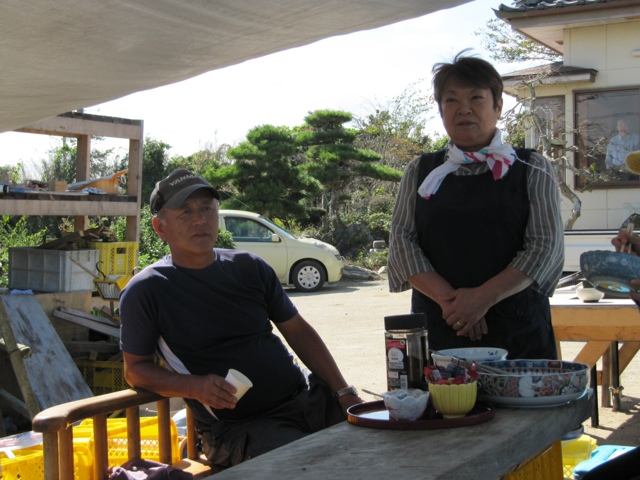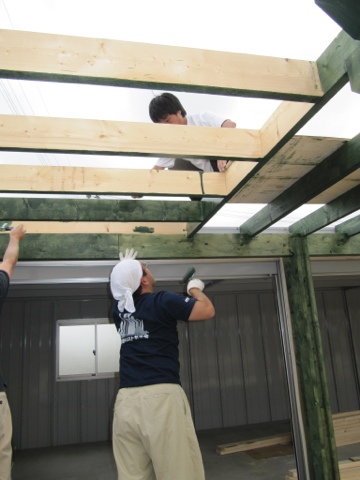The circumstances we are most familiar with include a professional greenhouse climate controlled cucumber growing operation and a second house on the property that acted as a sacrifice being totally destroyed itself but saving the first home. The wife of the cucumber growing operator suggested that the cucumbers had a much better living environment than the humans living in the home nearby ;) The field where the cucumbers were grown has now been sub-divided into 91 plots which will be used as a community garden providing food for the gardeners with any excess being brought to the "Asadori" or farmer's market (literally morning market) across the driveway.
Our story begins with an email from Miyako-san from Winnipeg who comes from Yamagata-ken (prefecture) just as Yayoi does. She let us know that there was a volunteering opportunity through a church based organization in Japan working on the Asadori Project. Yayoi emailed back and forth with Kodera-sensei until the details had been ironed out. Kodera-sensei is part of an organization MSR+ for Miyagi South Relief and publishes the web page 'M'iyagi 'S'outh 'R'elief+. I am sure donations would be very welcome!
On September 23, 2012 late afternoon Akio Okano took us to the nearby freeway interchange where Kodera-sensei (Wesleyan Church pastor) picked up these two 'hitch hikers'. He had just been to Narita airport where a mother and daughter had just flown in from Fukuoka, Kyushu. We drove north through Ibaraki, Fukushima to a community in southern Miyagi Prefecture called Iwanuma. We arrived at a community centre here at ten pm after about five hours on the road including two Service Area rest stops. Five of us slept here and had an interesting breakfast in the morning with the help of his son Tadashi-kun who appeared with various locally grown vegetables. Afterwards we were taken to the property of the community leader (cucumber grow op). Here was an impressive looking deck, gazebo and metal sheds around a courtyard of soil. The decking and gazebo were in need of wood preservative. The carpenters on site were proud to inform us that the 2 x 4 style lumber came from Canada (Tolko). The structure has been built on faith with the hope that funds will come from Canada after a board meeting of HOPE International Development Agency. Since the weather was rainy we were not able to paint on September 24 and instead we built a couple of benches with left over lumber and a couple of other jobs.
We were joined by other volunteers from Yamagata-ken, Shizuoka-ken. Oka-sensei from Yamagata-ken happens to be the former pastor of the church that Miyako-san from Winnipeg used to go to when she still lived in Japan. Ota-san is a Korean, born in Japan and thanks to ludicrous Japanese government policies has never been given citizenship. He even had trouble finding decent employment and has branched out to do business in other Asian countries. The mother (Mikako-san) and daughter (Hiromi-san) have lived in many places. Mikako-san lived in Bolivia for a period of time. The daughter has only lived in Japan for two years. She is currently in a pre-med program in the USA. There are many other life stories. One of the volunteers lost an elder brother and father in the tsunami.
Later in the afternoon Kodera-sensei took his original four passengers for a tour of the local devastation. This was more than a year after the disaster and was still quite moving. What do you do with tons of garbage? There were at least two new incinerators in operation nearby, but that does not take care of all the garbage or "gomi". After the tour back to the job site for a delicious dinner prepared by the owners of the property.
On September 25, 2012 we were able to begin painting and managed to finish one coat with tea/coffee breaks and a delicious lunch. Our youngest volunteers Tadashi-kun and Hiromi-san as well as probably our oldest volunteer Ota-san (age 69) spent time on top of the gazebo painting.
That evening we enjoyed a most amazing barbecue of fresh vegetables and the most meat I have ever seen (or eaten) in Japan. Tadashi-kun as usual was quick to get involved as the cook. We ate and ate and more packages of assorted meats materialized (how about pig intestine anyone?). I was beginning to think we should have paid for the honour of volunteering considering all the terrific meals our Iwanuma hosts, the Okazaki-sans were feeding us. We were expecting to eat the curry and rice that had been started at the community centre.
Both evenings of the 24th and the 25th up to eight of us piled into Kodera-sensei's Honda wagon and off we went to the public bath in Natori. On the 24th Tadashi-kun and another volunteer also came along in the little mini-pickup driven by Tadashi.
Anyway September 26 we had rice and curry for breakfast. We painted the gazebo structure one more time while the carpenters finished installing the glass sliding doors on the peripheral shed like structures and the electricians began wiring and lighting the place. Very professional looking! We had curry for lunch thanks to the Okazaki-sans. It was very delicious. Have a look at the pictures in Picasa to see the ¥28 (about $0.37) a piece Sanma fish, "totemo oishi", that is very very delicious. At about five pm we took Ota-san and Oka-sensei to the local train station and three of us (Kodera-sensei driving) set off back home to Ibaraki-ken. Again we made two stops at Service Areas, at one of which Yayoi and I ate curry udon (noodles). You can never have too much curry. At about ten pm we got safely back home. Thank you, Kodera-sensei an excellent driver.
Another project that MSR+ is involved in is the use of EM (Effective Microorganisms) to aid in plant growth and neutralize the effects of salt contamination of the soil. But that is another topic.
Kodera-sensei has already published his version of the Asadori Project on his BLOG at Asadori Project BLOG.
Click on Tsunami Volunteers to see photographs on Picasa.





No comments:
Post a Comment